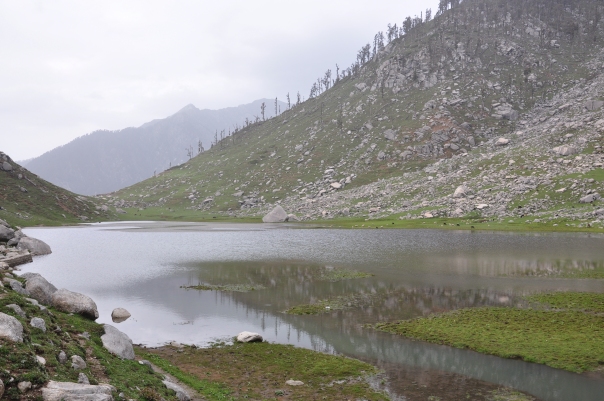
As I crossed the ridge, quite out of breath after the three and a half hour’s stiff climb, my eyes fell on Kareri lake, with the Dhauladhars rising majestically from its banks. It was like a jewel shimmering in the midst of that vast landscape! Kareri dal is a natural lake at an altitude of about 11000 feet, fed by the glaciers of Minkiani Pass in the Dhauladhar range of Upper Himalayas. We had trekked for 3 days to reach this piece of heaven on earth. The lake can be reached directly from Kareri village, involving a trek of 13kms, but we had taken a circuitous route and returned to the road head through Kareri village.
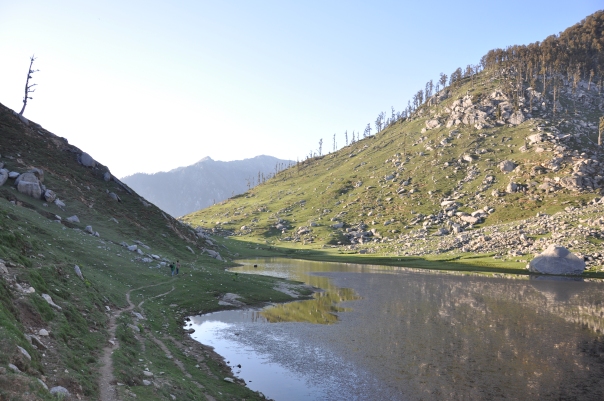
Every summer, as the temperatures soar in the Indian plains, the higher regions of the Himalayas beckon the avid trekker. And forgetting all the travails, the weary feet, and the leaking tents of the earlier treks and buoyed by the selective memories of the time spent in the lap of nature, the trekker starts collecting the gear for yet another hike in the Himalayas. Believe me, the pull is very strong.
There are two ways to do this trek. You have to reach Dharamsala in either case and from where arrangements have to be made for porters, guides and provisions. The route commonly taken is Dharamsala – Gera(roadhead) – kareri village – kareri lake – Minkiani top – Kareri lake and return the same way. The other route (which was what we took) is Dharamsala – Salli(road-head)-Chandrela Mata Mandir – Daler – Kareri lake – Minkiani top and the return is through Kareri village and Gera. The first night, after engaging the cook and porters and making other arrangements at Dharamsala, we halted at Drini Forest Rest House, an hour’s drive away. The Rest House was well maintained and we spent an enjoyable evening and the next morning there on the lawns.
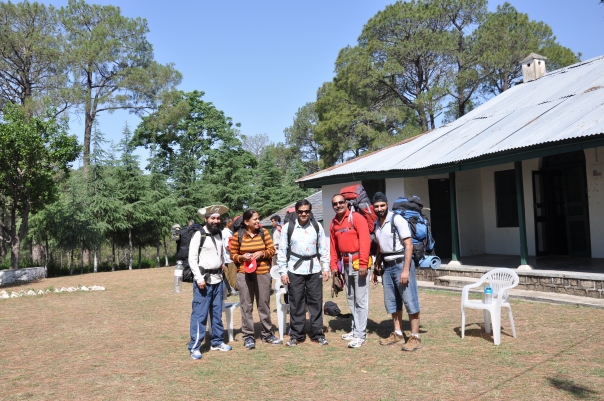
Day 2:- Our rucksacks packed, we left Drini after breakfast for Salli village, 8kms away, on a hired jeep, and started the first day’s trek of 6-7 kms to Chandrela Mata Mandir(temple). The terrain was initially barren and with the sun blazing, the uphill walk was quite tedious till we reached a stream and had our first break. With our shoes off, sitting on the rocks with feet in icy water and sipping fruit juice and munching biscuits, we got into the groove of Himalayan trekking. The rest of the trek was along the stream as the path ascended gradually and there was more vegetation.
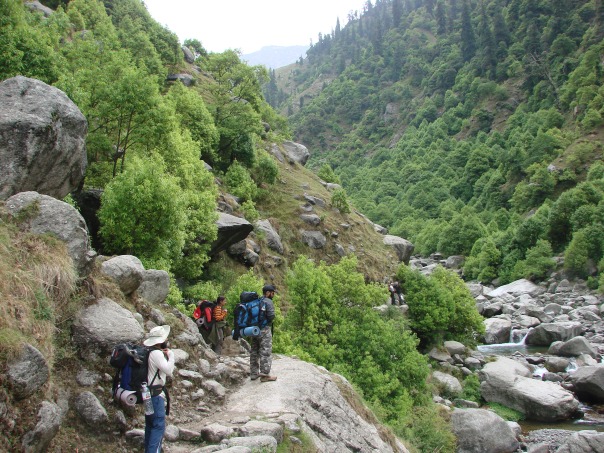
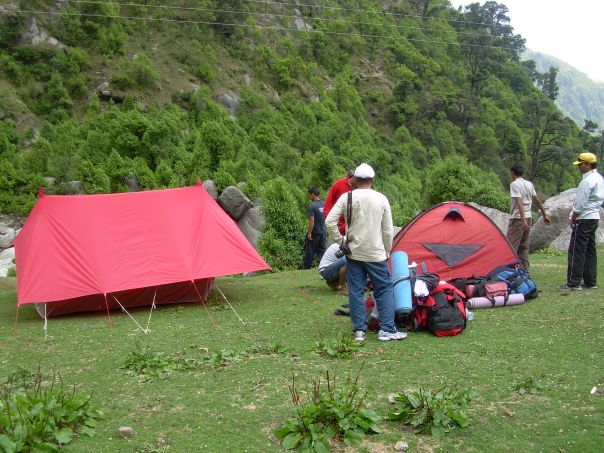
This is a well trodden path with villagers going to the temple, women returning from the forests with sacks of lungdu, a variety of leafy greens, which is a speciality in this region. We were to taste this eventually when we had lunch at the home of our cook in Kareri, our last camp. We reached Chandrela temple at around 2 in the afternoon. After stopping briefly at the temple of the Goddess, which was manned(?) by kids who blew the conch and put a dash of vermillion on our foreheads, we pitched our tents on the grassland adjacent to the temple. An unused shepherd hut was to be our kitchen, and the same pattern followed at the higher camps too. A huge flat-topped rock served as our sit-out, chatting room, dining table and lying on it after dinner, facing the star-studded sky and identifying the constellations, it somehow seemed it was worth all the trouble that was taken to reach here.
Day 3:- There were dark clouds in the horizon as we left the campsite after a breakfast of parathas and pickle with tea. The day’s trek was along the stream as the boulder-strewn path ascended gradually. There was very little vegetation and but for the interest generated by the hydropower project that is coming up in this area, with the tunnel for the watercourse nearing completion, there was nothing much to recommend for the day’s route. A little drama while crossing the stream, which required jumping from boulder to boulder, with two participants slipping and getting wet, and we were through with the day’s trek as we clambered up, passed the shepherds’ huts and reached our campsite at Daler, at the base of Baliyani Pass.
And what a campsite it was! It was a flat meadow with fresh grass that had come up after the snow had melted and the lower ridges of Dhauladhar loomed all around. The topmost ridge to the right was our next destination as Kareri lake was beyond this ridge. Every time we looked up in that direction, a little apprehension crept in, despite years of walking in the Himalayas, as the trail seemed very steep and quite difficult to negotiate. This place got the name Daler as the excess water from the Kareri Dal(meaning lake) used to overflow from over the ridge to this area. Now, the excess water from the lake has been channelled to flow down on the other side to Kareri village through the Kareri nallah. We spent a wonderful and sunny evening at this camp, interacting with the Gaddis (the shepherds who take their flock of sheep every year for grazing in the high grasslands which come up after the snow melts) and were treated to tea and fresh khoya ( thickened milk) by a warm-hearted gaddi woman.
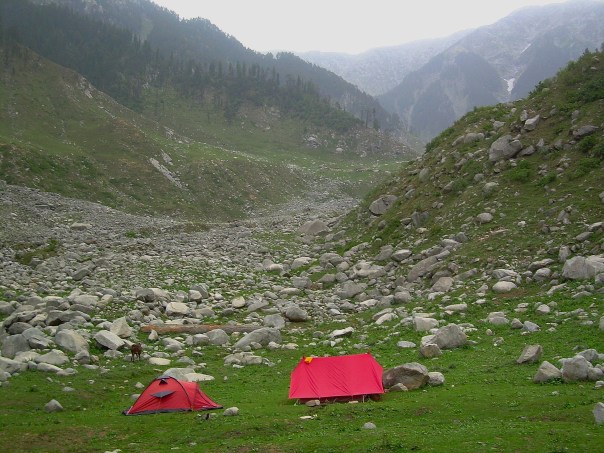
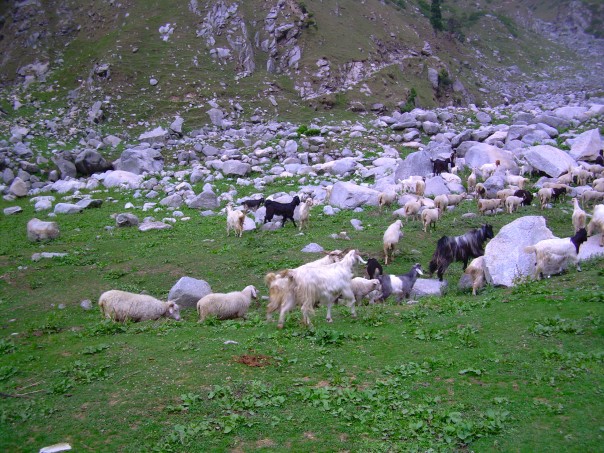
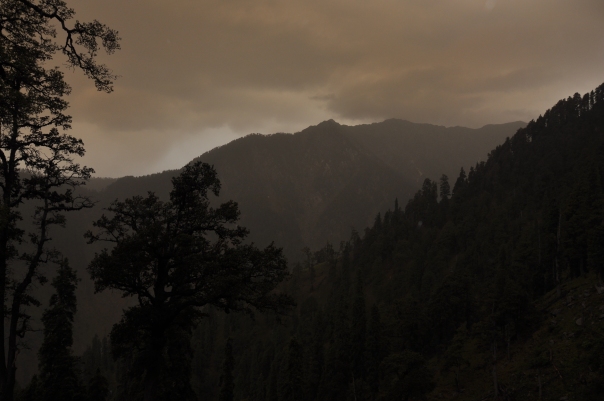
Day 4:- It was not a clear day and dark ominous clouds were gathering all around. We debated on whether it would be better to leave early and go through the stiff climb before a heavy downpour or wait till it rains and the weather clears up. We finally took our guide’s advice and set off soon after breakfast. This trail was not only steep but also risky at certain patches, which had to be negotiated carefully, consciously keeping to the mountainside, as an accidental slip could mean a fall down the steep gorge to the right. To add to the woes, it started raining and climbing became more difficult with the rain sheets. A first-time trekker of the group used all fours to negotiate the risky stretches and this was promptly categorised as “octopus-style climbing”. It was a very sensible thing to do, under the circumstances. No looking around, no photography – we concentrated only on where our next step was going to be. After an hour and a half of this kind of scary climbing (thrilling in retrospect), we took a break as we had covered half the distance and had crossed the “danger area” as our guide put it. It was still drizzling and we huddled within our rain sheets, and de-stressed by munching biscuits and wafers. We covered the rest of the trail in an hour and crossing the ridge, came upon huge grasslands and then the lake. As I said earlier, it was indeed like a shining jewel in the midst of that vast landscape.
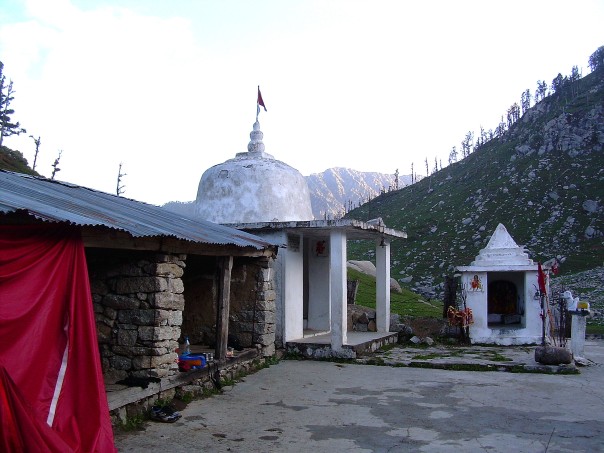
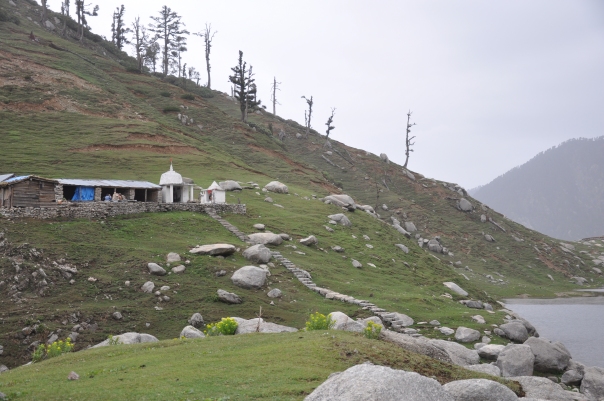
There is a temple on the banks of the lake, with a few make-shift log huts (with no doors – just stacked logs and a tin roof) but having a large cemented terrace overlooking the lake and facing the Dhauladhars. We set camps in these huts and had all our meals on the open terrace, around the fire on which the food was being cooked. Soon after we had reached Kareri lake, the weather changed again dramatically with hail storm and heavy rain, which is typical of Dhauladhar ranges.
Day 5:- We did not have to move camp this day and everyone was relaxed. We had no specific plans for the day – just walking around the lake, through various trails leading to shepherds’ huts, up the trail leading to Minkiani Pass and as far up the glacier as we could climb without difficulty, on to an adjacent meadow for a game of cricket, lazing under the sun on the terrace with a book and of course, waiting for the next meal. It was such a wonderful day, spent in the lap of nature, with good food and friends around, far from the worries and stresses of urban life.
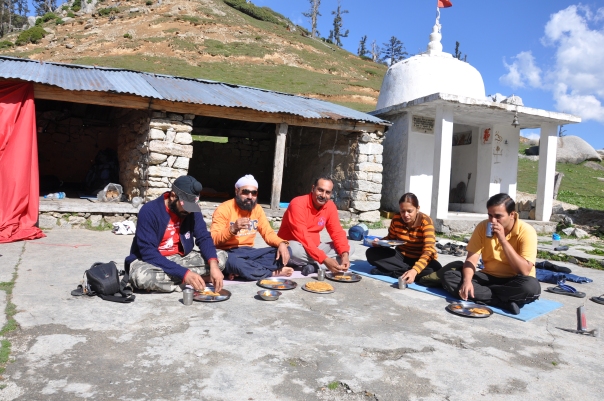
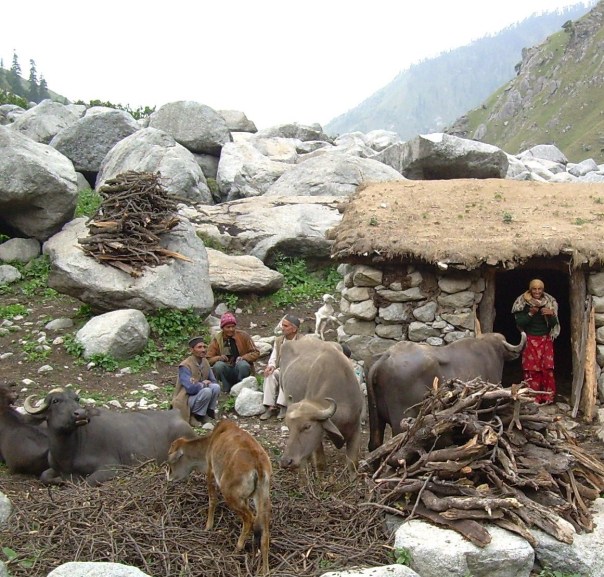
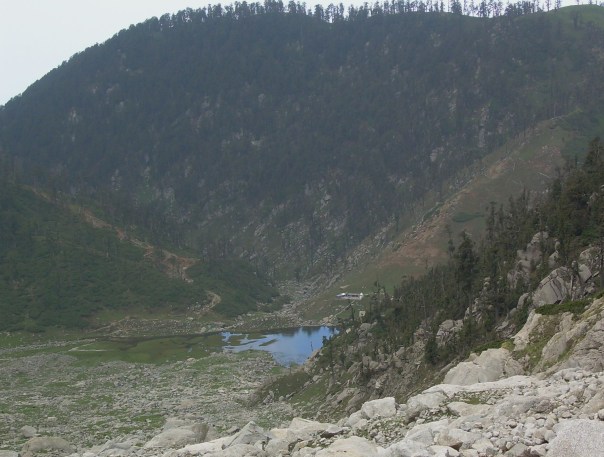
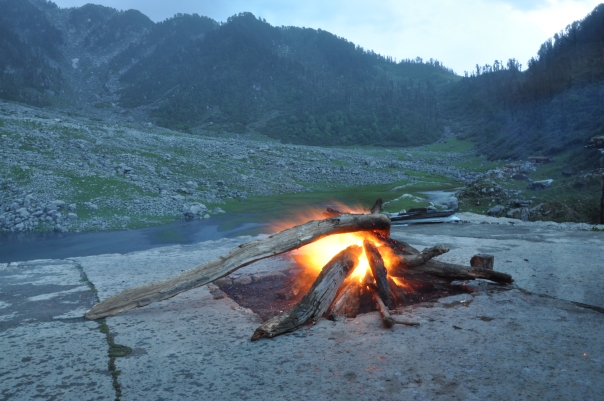
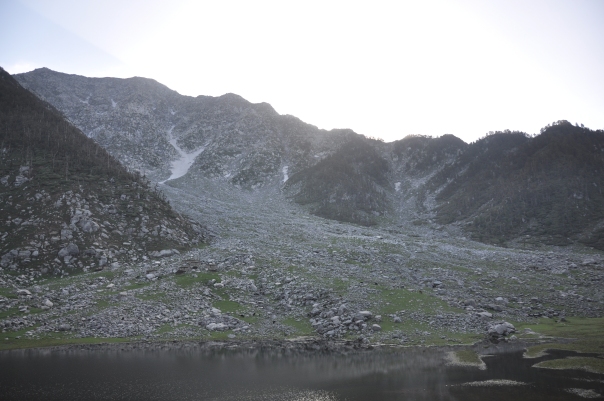
Day 6:- We left Kareri lake after breakfast and started the downhill trek of 13 kilometres to Kareri village. It is a beautiful trail passing through forests, with the gurgling stream never far away, and but for the length of the trail and several steep stretches (which take a toll on the knees and toes) it can be rated as one of the most delightful hiking trails of the Himalayas. We reached Kareri village at around 2 in the afternoon and stayed at the old and poorly maintained Forest Rest House, built during the British time. The cook belongs to this village and he invited us for lunch at his home. We had no energy to explore the village that day.
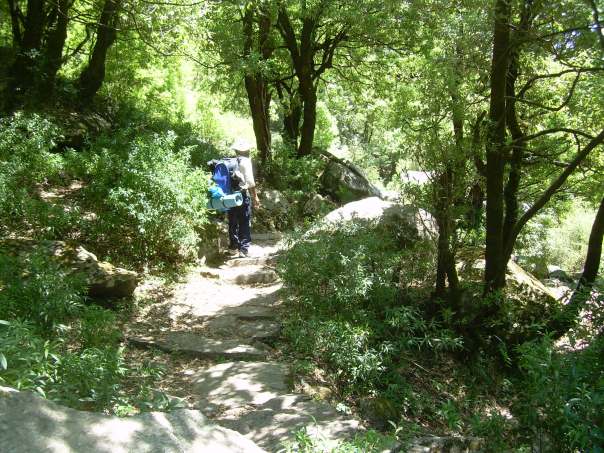
Day 7:-In the morning, feeling fresh and energetic again, we walked through the village, its alleys and terraced fields and were invited by many to enter their homes and have tea. It was a pity we could not say yes to all of them. The village has a primary and middle school, and almost all the children continue their schooling in the High School at Gera, involving a 12 km walk every day. After breakfast, we too walked the 6 kms to Gera and then onward to Dharamsala.
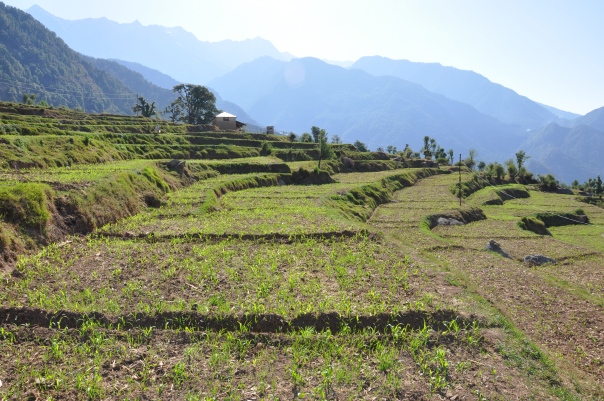
This was a nice, circular hiking trail, which took us from 5000 feet to a height of 11000 feet, through green meadows and forests, glaciers, lake, shepherd huts and a vibrant village with hospitable folks.
Wow Perimma! I am so tempted to be a part of such treks! Let me know the next time you plan for such a trek. I will try to participate (If i am allowed to). Meanwhile i will get myself physically eligible for it..
LikeLike
Hi Vaidehi
What dates did you go on to Kareri? I am planning for 15-18 August now, but I am apprehensive about the heavy rainfall. Pls suggest.
Can I speak to you? My no. is 9899144024.
LikeLike
Hi Nimesh, I had done the kareri lake trek in the month of May. August is really not a very good month for himalayan hikes except valley of flowers which is done only at this time notwithstanding landslides etc. If you do kareri lake early May, you will be able to trek further up to Minkiani top, totally in snow. Of course you require a guide.
LikeLike
Hi,
How will the weather be in April end in Kareri lake? Will it be covered by snow or there will be grasslands to pitch our tents? Also, can we see snow capped mountain ranges from the lake in April end?
LikeLike
Hi Somnath, there has been very little snow this year all over the Himalayas. So, pitching tents around the lake should not be an issue. As I had mentioned in my post, the route taken by us was an unconventional one. Take the direct route from kareri village and take a guide along. Enjoy the hike and the camping at the lake.
LikeLike